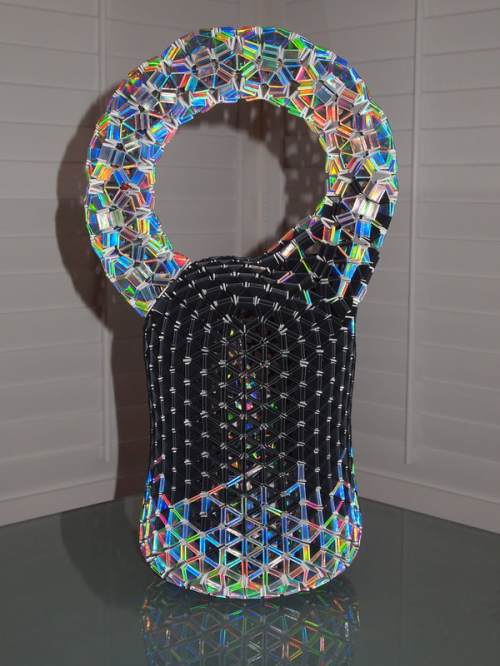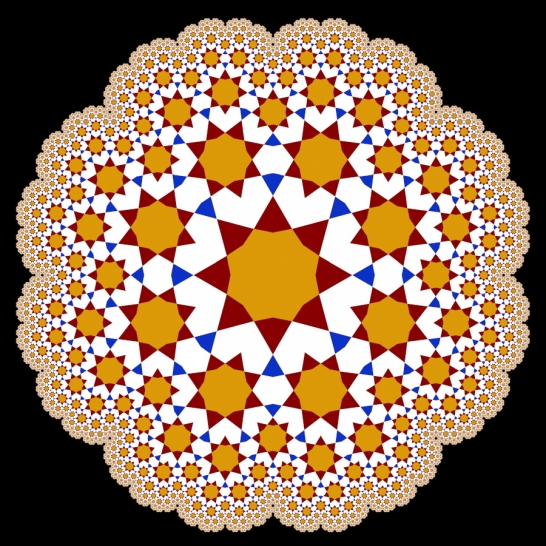The Regional Meeting of the Golden Section of the Mathematical Association of America was held at California State University, East Bay. The local organizer was Shirley Yap, fellow mathematical artist, who deserves kudos for the monumental amount of work it takes to organize a conference like this! I helped out by organizing this year’s Art Exhibition.
This year, I thought I’d give you a virtual tour of the exhibit! So I asked contributing artists to submit their own personal statement about their work and/or mathematical art in general, as well as an image of one of their displayed artworks. I’ll let the artists speak for themselves…. (By the way, the order the artists are presented in is the order in which they sent me their information. There is no ranking implicit in the order.)
Shirley Yap (shirley.yap@csueastbay.edu)

I created this image out of golden spirals. While working on a math demonstration for my students, I unpacked a roll of netting. During the unraveling process, I had a vision of a two-dimensional golden spiral unravelling, which I tried to recreate with code. I wanted to viewer to not just witness the unraveling, but also be inside the web of the fabric. I often create code that has a lot of randomness in it, so that it captures a moment in time that can never be recreated.
Frank A. Farris (ffarris@scu.edu and math.scu.edu/~ffarris)

Mathematicians can feel lonely to find ourselves face to face with the most beautiful thoughts humans have ever known, only to realize that communicating our experience is unreasonably difficult. I have found comfort in visual art, digitally computed images that are the best I can do (short of giving an hour lecture) to say, ‘This is the beauty of mathematics.’
David Honda (snaporigami@gmail.com and snaporigami.weebly.com)

I’m primarily a middle school mathematics teacher with one of my hobbies being Origami and other paper crafts. Some years back I became interested in the work of Heinz Strobl which uses joined, folded strips of paper to create various structures. Much like unit origami, the structures are held together solely by the folds, no adhesives. My interest soon became an obsession and I’ve been neck-deep in little strips of paper ever since. Lately I’ve been exploring concepts in Topology. This particular work is my attempt at a Klein Bottle.
Dan Bach (www.dansmath.com, art@dansmath.com, and @dansmath)

“I’m a career college mathematics teacher, now an interactive book author and 3D math artist. I like to illustrate number theory and vector calculus principles with surprising and colorful images, using a software palette of Mathematica, Cheetah3D, and iBooks Author. My math art encourages viewers to think, notice, and wonder. And hopefully say, ‘That’s cool! That’s math?’ “

This is a visualization of seven repeated perfect out-shuffles of a deck with 128 cards. The horizontal lines represent the particular orders of the cards throughout the shuffling, and the vertical curves represent the path each card takes from start to finish. The curves are colored from black to white in order to show the mechanics of the shuffling. The dots are colored from black to red to black in order to show that each perfect out-shuffle preserves the so-called “stay-stack principle”. Notice that the order of cards returns to the original order after seven shuffles.
Linda Beverly (lbeverly@horizon.csueastbay.edu and https://mathcsresearch.wordpress.com/)

This image is an embedding of a photograph of a set of watercolors. The embedding was performed using Locally Linear Embedding (LLE), a nonlinear dimensionality reduction technique, introduced by Saul & Roweis in 2000. LLE is an unsupervised machine learning algorithm.
I am pursuing a double major in Mathematics and Computer Science. I am currently working on research in geometric dimensionality reduction and unsupervised machine learning. This work will be extended into neural networks and deep learning. I enjoy seeking out interesting intersections between mathematics, computer science, and art.

Undulating organic light show with minimal code generated by a 16 MHz processor calculating color and brightness values through a Perlin noise algorithm. Blobs appear to grow, shrink, and drift relaxingly over the LED grid. 100 ping pong balls covering 100 individually addressable LEDs on poster board with Arduino Nano v.3 controller and battery pack.

Programming is my art. I might not be a good “designer”, but I am a good developer where I am able to take a structured approach on art. I specialize in computer graphics, thus my understanding of the mathematics behind geometry, 3D models, and 2D sprites are better than my ability to free-form draw them.

All of my work stems from one core impulse: to celebrate the inherent beauty of mathematical forms. Since traveling to India in 2012, I have been particularly focused on blending traditional Islamic motifs with polyhedra and fractals. The results are distinctly Islamic in flavor but with a modern twist.
This piece has global and local 8-fold rotational symmetry around each gold star. Star centers occupy the nodes of 8 fractal quaternary trees, which are pruned at the octant boundaries. The original central star is replaced by an inward progression of the same fractal diminution.
Vince Matsko (vince.matsko@gmail.com, www.vincematsko.com)

This piece is based on fractal binary trees. The usual way of creating a binary tree is to move forward, then branch to the left and right some fixed angle as well as shrink, and repeat recursively. Recent work involves specifying the branching by arbitrary affine transformations. In this piece, the affine transformations were chosen so that as the tree grows, nodes are repeatedly visited. The nodes are covered by disks which become smaller with each iteration, accounting for the overlapping circles. The research needed to produce these images was undertaken jointly with Nick Mendler.
I hope you enjoyed this virtual tour of the Art Exhibition at the recent MAA Regional Conference. The upcoming conference is next March; stay tuned for another virtual tour in about a year!















